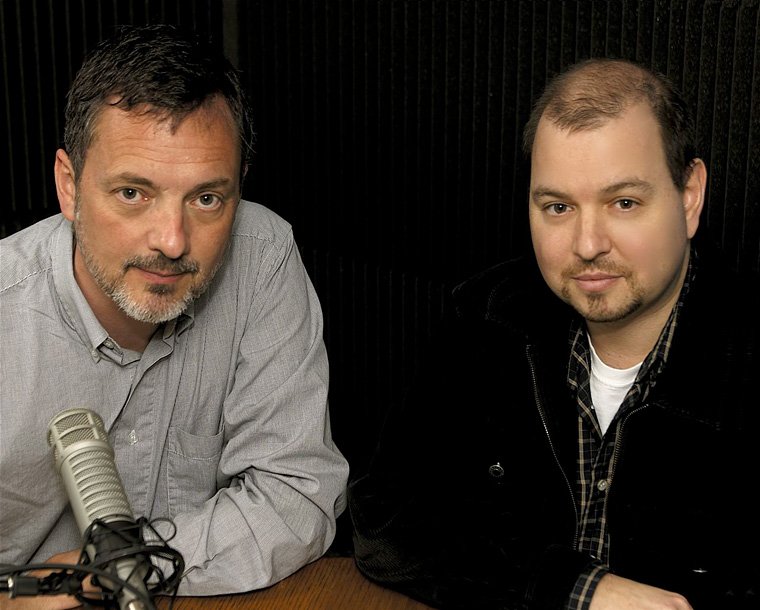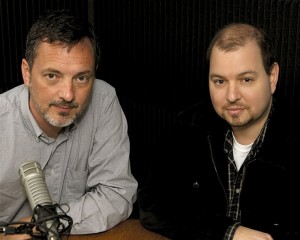The NACOcasts: Podcasting is changing the way orchestras communicate with audiences
An Interview with Chris Millard and Maurizio Ortolani
Ann Drinan: What are your backgrounds?
Chris Millard: I was principal bassoonist in Vancouver for 29 seasons, and I took over the principal chair in Ottawa during the 2004-05 season. I studied at Curtis.
Maurizio Ortolani: I have a fine arts background. I managed a few festivals in Ottawa, and then started a consulting company to help arts organizations with their Internet communications strategies. I became the NAC’s New Media Producer in 2000.
AD: Chris – how did it come about that you host these NACOcasts? Did you have any prior experience in radio or interviewing?
MO: Can I answer that? … I attended a NACO performance where Chris was the featured soloist in the Mozart Bassoon Concerto, and I saw Chris address the audience. Jaime Laredo was conducting, and the two of them talked about the performance during the concert. Chris’ preparation, eloquence and charisma were extremely impressive and I thought, “We have to get this guy doing a podcast.“ It has been a huge success; he does excellent research, he writes well, and he hosts the shows like a pro.
CM: The hard part is keeping on top of it – my biggest problem is having the time and coming up with ideas for new programs.
MO: We envisioned it as an outreach vehicle – we wanted to use the emerging technology of podcasting, which has such great potential for an organization like ours. We were actively looking at designing a podcast program around the orchestra, and we came across Chris’ talents.
We also have a French language music podcast, BaladOCNA, hosted by Marjolaine Laroche (NACO’s assistant principal bass), about the day-to-day life of the orchestral musician. She took a short break, but it’s coming back this spring. And we also produce a podcast for the NAC’s English Theater program with Peter Hinton, for French Theater with Paul Lefebvre, and for our NAC Orchestra tours and festivals.
Marjolaine’s French podcast series is very different in character from Chris’ NACOcasts, which are studied and thoughtful (as well as funny). The French series is irreverent, off the cuff, and more spontaneous, totally in keeping with Marjolaine’s personality.
AD: Chris, do you have artistic autonomy? Do you get guidance from NACO staff or can you make all programming decisions?
CM: I have complete autonomy. I certainly get suggestions from the staff – I use some and not others. The original intent was to make the podcasts be concert promos that contained meaningful content about artists and repertoire. I realized quickly that I didn’t want to just put up advertising pieces for concerts. Anyone can do that, and a lot of what we hear are basically promos. I really felt that I didn’t want the podcast to become a way to fill the hall – I wanted to engage audiences. Since I’m already preaching to the converted, why not give them something more in-depth? I use the podcasts to delve into the music.
They tend to run along one of three themes:
- 1. an in-depth discussion of a particular piece on the program
- 2. a casual but meaningful conversation with the conductor or guest artist
- 3. a discussion of the business end of orchestras – orchestra contracts, the relationship between the conductor and musicians, musician injuries, the instruments themselves, etc.
The April 2007 podcast with Canadian violinist James Ehnes turned into a fascinating discussion of Stradivari instruments rather than his upcoming performance.
I assume that I’ll leave some listeners behind with the level of detail I get into; some might not understand everything but they love that we don’t skim through the material. I talk about the harmonic series, the production of sound – it’s at a level of an introductory master class at a music conservatory.
MO: The feedback we’ve received is that people appreciate being engaged by an authority like Chris and they like the intimacy of the program. They feel that they’ve been allowed beyond the proscenium and can come backstage.
AD: How many hours/days does it take to put a typical show together? Is the diary that appeared in Symphony magazine typical? [Click here for a link to the Symphony article on the ASOL website.]
CM: The Messiah podcast we talked about in Symphony was the most time I ever spent on one. Some of them are very easy. For the interview ones, I spend about 3-4 hours studying the material before the interview. Maurizio spends some editing time – we’ve gotten better at keeping things flowing during taping and not relying so much on post-production editing.
AD: Tell me about the other technical initiatives you’re involved with at NAC, such as next generation e-learning.
MO: We currently produce websites, webcasts, and podcasts; we stream audio from our recent recordings and live concerts; and we create modules for tours and music education programs.
Our online education initiative is called ArtsAlive.ca. It’s a one-of-a kind performing arts website for students, parents and teachers.
Our other main focus is“next generation” Internet. Pinchas [Zukerman, NACO’s music director] is a champion of distance learning and broadband video conferencing for the master class environment, using CA*net4 in Canada and Internet2 in the US. We’re actively using these networks as a platform for distance learning.
Most universities have Internet2 on campus but the music departments don’t use it. The medical, business, and law schools do but it seems the other departments don’t know about it. If tweaked properly, broadband video conference is a fantastic medium for conservatories.
CM: I’ve watched Pinchas giving classes to students in Manhattan – it’s 95% as if he were actually there in person.
MO: This is the future of music education; it allows connections between the instructor and student that would not otherwise be possible. We’ve produced ‘cellist Lynn Harrell and trumpeter Jens Lindeman, a member of the Canadian Brass who’s on the faculty at UCLA.
CM: Once it’s in place, it’s so inexpensive to put an Internet2 videoconference together.
MO: It’s a minimal investment because the university already pays for the I2 subscription. The videoconferencing equipment costs between $2000 and $6000, so all you have for each conference is the cost of an audio engineer for a few hours.
AD: What’s the difference between webcasting, podcasting, and on-demand audio?
MO: It’s the delivery mechanism. When you’re streaming a simulcast, all you need is a radio license, which is quite affordable. There’s no media residing on the user’s computer; nothing gets transferred. Podcasts are different, which is both good and tricky. It’s good because it’s content that you want to listen to, when you want, and how you want. You download the audio file and then listen on your computer, on your iPod, or burn it to a CD and listen in your car on the way to the concert. However, a whole host of copyright and rights issues are involved in using music in podcasts – there’s no overarching agreement like the radio agreement in the US that covers streaming audio. It’s subject to SOCAN fees, which are the equivalent to ASCAP/BMI (i.e., composer’s) fees. We have draft legislation in Canada but nothing like the ASCAP/BMI podcast license that exists in the US. Mechanical rights still have to be negotiated. There’s a lot of legwork just to include even one piece of licensed music, which limits the audio you can use.
CM: If I could run it like a radio station, I could compare performances, compare artists, etc. Because of the restrictions, our solution is a compromise – every NACO concert that’s played is archived, and we have permission to use 4-minute segments. The recording quality is OK – it varies from year to year (older concerts are on cassette and CD) – and we just use two mikes. It’s not radio quality but it’s OK for podcasts.
AD: Tell me about the license agreement with the musicians – 4 minutes of archival tape permitted. Did you use the AFM’s Internet agreement?
CM: Canada opted out of the Internet agreement, so it doesn’t pertain. Orchestras negotiate license agreements on a case-by-case basis.
AD: What do your colleagues think of the podcasts?
CM: Some listen regularly, some occasionally, and some don’t listen at all. But they seem supportive that I’m doing them.
MO: It wouldn’t be as successful if it were done by a programmer or someone else in management. It works best that the host is an artist.
We’ve done about 30 podcasts since we started in February 2006. For conductors, I’ve interviewed Pinchas Zukerman, as well as NACO’s Principal Youth and Family conductor Boris Brott, and Principal Pops conductor Jack Everly, plus Andrew Litton and Gustavo Dudamel [whose NACOcast is currently featured on Polyphonic.org]. For composers, I’ve done Michael Torke and Oliver Knussen.
Issue podcasts included instrument-related injuries, the role of conductors, and the working life of symphony musicians. I’ve interviewed several of my NACO colleagues, including Joel Quarrington, Principal Bass; Nick Atkinson, Principal Tuba; Chip Hamann, Principal Oboe; Doug Burden, Bass Trombone; and Jessica Linnebach, violin.
Guest artist interviews have included The Canadian Brass and violinist James Ehnes, plus CBC Radio host Eric Friesen. Some of the pieces I’ve featured include Bach’s B minor Mass, Stravinsky’s Pulcinella Suite, Messiah, and a program of Hungarian music, plus Brahms, Dvorak, Beethoven – the usual suspects.
CM: Next year we’re trying to come up with agreements to promote the orchestra through other mechanisms that we’ve seen. We’re ahead on podcasts but behind on what the New York, Los Angeles, London, and German orchestras are doing regarding accessibility of programs on the Internet.
However, the NAC Orchestra was the first major orchestra to release an entire symphony as a free downloadable MP3. We released Beethoven’s First Symphony in 1998 during our Canadian tour.
AD: Maurizio, what technical issues are involved in producing a podcast?
MO: The Symphony magazine article you just mentioned has a sidebar full of technical information about podcasts. A few highlights:
Any computer with access to the Internet, and now most mobile devices with wireless Internet, can access podcasts. When we first started producing NAC podcasts, we began the way many organizations do—using free software and inexpensive equipment. Audacity, for example, is a very powerful, free audio recording application available for Windows, Macintosh, and Linux. Coupled with two or three relatively inexpensive microphones and a $50 mixer, you have the basic requirements for recording and editing audio on a personal computer.
We migrated to a more traditional recording suite, one that allowed us higher quality and faster output. Our current setup includes studio-quality microphones, a mixer, and a solid-state recorder. Once the MP3 file is exported from the audio-editing software, it needs a few more touches before it’s ready to be put on our web server. Numerous free applications allow you to create and edit the ID3 tags of an MP3 file.
Podcast RSS (Real Simple Syndication) files, which contain information on the podcast that’s then delivered to subscribers, are usually stored on the same server that hosts the podcast’s web page. A variety of applications enable users to subscribe to your RSS “table of contents.” Once users have subscribed, any new episode of your podcast is downloaded to them whenever it becomes available.
A number of web services offer all-in-one podcast solutions. These are wonderful services for those starting out with limited resources, time, and/or budgets. The downside is that the podcast is hosted externally and won’t have the look and feel of your organization’s site. The upside is that many of the headaches are handled for you by outfits that make podcasting their business.
For more information about some of the podcasting applications I recommend, see the Symphony magazine article.



No comments yet.
Add your comment